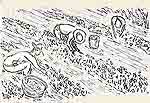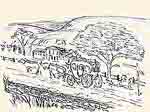|
He Came to America
Richard Thomas Starsmeare
20th October 1828 - 18th April 1923
by
Born in Chelsea to Stephen Starsmeare & Sarah (Scriven), Richard was
the third child of the family. He was born along Leader Street, South
Chelsea, and was baptized in St. Luke's Church on the 14th November the
same year. Nothing is known of his early years, but I do not expect life
was a bed of roses at this time in the confines of London. Also, I do
not expect he had much schooling. This was only available to the more
affluent at the time, so as we go along with this story the spelling of
his name will change, remember even the people that had education could
only spell a name the way it was pronounced.
In 1847 at the age of 19, Richard embarked on a voyage to a new life.
To leave your parents and your brother's and sister, knowing that you
are unlikely to ever see them again, and even, more, if you are unable
to read and write, not to be able to communicate with them in any way,
must take enormous courage. This, in my mind, makes him a very special
man. He sailed from England (port unknown) in a "sailboat and required
114 days on the water before making a landing in Montreal, Canada." I
wonder just what the conditions were like on a sailing ship tossed about
on the Atlantic….
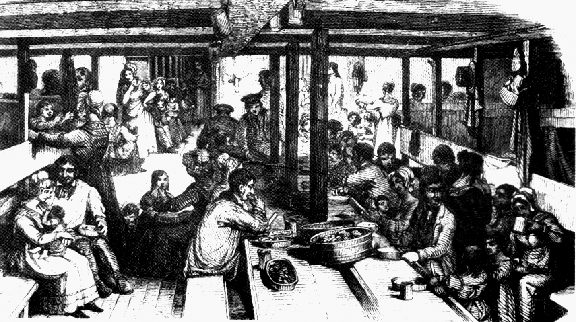
The next we know of Richard is at the start of the 1850's. I believe
he married in 1851 because his daughter Delila/Emma (I am not sure of
this child's name, on some references it is Delila and on others Emma)
was born in Cape Vincent, Jefferson Co., NY, in 1853. This is the only
child I can find from this marriage. Richard's first wife was Ruth Lee,
born in Jefferson Co. in 1836, but she must have died early. Delila/Emma
turns up later in the 1870 census for Wetmore, County McKean, Pa., together
with Richard and his second wife Fannie. In 1858, he is working for the
Watertown & Rome Railroad Company and is residing in Cape Vincent. In
1857 he applies for US citizenship and this is completed in 1859.
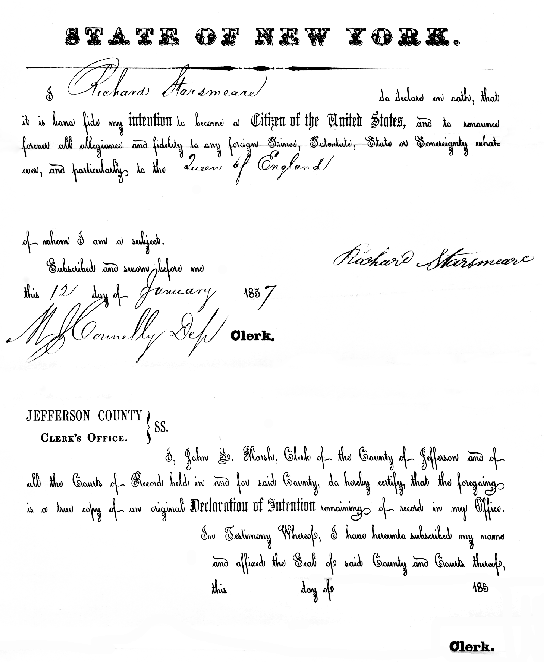
A couple of months ago I was researching on the Internet and I came across
a site called The Crooked Lake Review, and there was a story
written by Richard Palmer about a locomotive called The
Young Lion of the West in which our Richard plays a role.
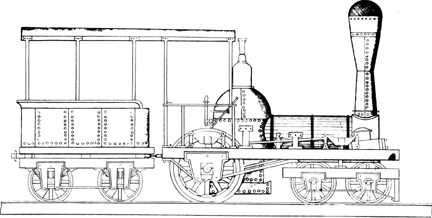
The part we are interested in comes from an account in the Utica Morning
Herald of Saturday, May 22, 1858.
The Locomotive "Lion," which terminated its existence in a tragic manner
the other day on the Watertown & Rome Railroad, had quite a history
and was well known to railroad men. It was built by Norris about 1840
or 1840 for the Auburn & Rochester Railroad, and was the second locomotive
the company owned.*
The name it then had was, "Young Lion of the West" and although small
in capacity it did excellent service on the strap rail. As the machine
was familiarly called "Lion" by the enginemen, the title of "Young"
became inappropriate and was dropped off the name save "Lion."
When larger locomotives superceded it, and after serving the company
10 years or more, the "Lion" was sold to the Watertown & Rome Company
and was used on their road as a repair engine. In this capacity it terminated
by explosion costing a human life.
* Richard Palmer's note: Apparently there was a lapse of
memory on the part of whomever the newspaper had interviewed. The "Lion"
was the first locomotive on the Auburn & Rochester and was built
by Rogers in Sept., 1840. (C/N 23) 12x18"x54." The second
locomotive, also a 4-2-0, was the "Ontario," built by Norris
in 1840, not the "Lion" as stated in the article. According
to a roster of locomotives dated Sept. 30th, 1836, the "Lion" or No.
12 went into service on the Watertown & Rome in June 1852. Its weight
is given as 13 tons with a 10 inch cylinder bore, 48" drive wheels;
a 7-ton tender, 1,000 gallons water capacity; had run 6,327 miles during
the year, and was reported in "Good" condition.
The story of the "Lion" now continues with an excerpt from
Edward Hungerford's The Story of the Rome, Watertown, and Ogdenburgh
Rialroad, Robert McBride & Co., New York, 1922, pp. 43 - 44:
It had started operations with four tiny second-hand locomotives…
the Lion, the Roxbury, the Commodore and
the Chicopee. Of these the Lion was probably the oldest,
certainly the smallest….
But, at the very best, he was hardly a practical locomotive even for
1851. And soon after completion of the railroad to Cape Vincent,
Lion was relegated to the round-house there and stored against
an emergency. That came three or four years after the opening of the
line. A horseman had ridden in haste to the Cape from Rosier—then
known as LaBranche's Crossing—with news of possible disaster.
"The woodpile's all afire at the Crossing," he shouted. "Ef the road
us goin' to have any fuel this winter you'd better be hustling down
there."
Richard Starsmeare was on duty that day at the round-house and he hurriedly
summoned the renowned Casey Eldredge, then and for many years afterwards
a famed engineer of the Rome road, and Peter Runk, the extra fireman
there. Together they got out the little Lion and made him fast
to a flat-car upon which had been put four or five barrels filled with
water to extinguish the conflagration. It would have been a serious
matter indeed to the railroad had that wood-pile been destroyed. It
was one of the chief sources of fuel to supply the new railroad. The
Lion, with its tiny fire-fighting crew, went post haste to
LaBranche's. But when they arrived the farmers roundabout already had
managed to extinguish the flames. …Case Eldridge reached for his watch.
"Gee," he said, "We shall have to be getting out of this. The Steamboat
Express will be upon our heels. Peter, get the fire up again."
Peter got the fire up. He opened the old firebox door and thrust an
armful of pine into it, the blaze started up with a roar. And the men
who were near the engine found themselves lying on their backs on the
grass beside the railroad….
They ploughed the Lion out of the fields around LaBranche's
for the next two years. Her safety-valve was turned out of the ground
by a farmer's boy a good two miles from the railroad. Starsmeare got
it and carried it in his toolbox for years thereafter. He quickly rose
to the post of engineer and in the days of the Civil War ran a locomotive
upon the United States Military Railroad from Washington, south through
Alexandria to Orange Court House.
It would seem that Richard was very lucky not to have been killed in
the above accident, but had it not happened and the newspapers had not
reported it, then I would not have had the opportunity to find out so
much about him.
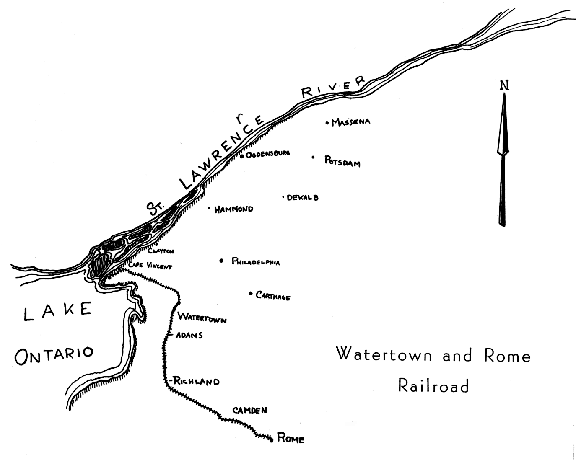
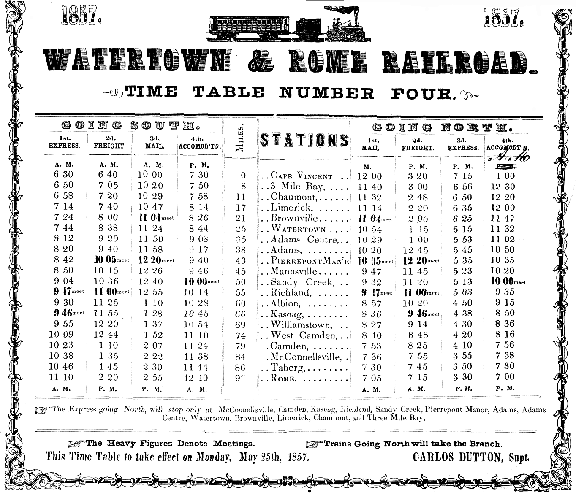
As stated in Hungerford's book, for the period of the Civil War (1862
- 1865,) Richard was traveling between Washington and Orange. Where he
lived at that time, I do not know, possibly in Rome. It was either sometime
during the above period or soon after that Richard's first wife Ruth,
must have died. And I think it was soon after that he made the decision
to move away from the area. He first moved to Pennsylvania on the 16th
of January, 1865, and lived in Wetmore in McKean County. He married his
second wife, Fannie D. Pickard, on the 16th of February, 1870, in Busti,
Chautaugua County, New York, and it was in Wetmore that he and Fannie
and Delila/Emma were in July 1870 according to the census, under the name
of Starsmaer. He was still living in Wetmore at the birth of his first
child by that marriage, Carrie Rose Starsmere, who was born in 1871. She
was followed in succession by Charles H., 1872; Maude, 1874; Roy R., 1878;
and Paul in 1879. Richard and his family are recorded on the 1880 census
for the township of Wetmore, McKean Co., under the name of Starsmen, but
Delila/Emma is missing. Then we move on to 1900 and the town of Kane and
to the house in Kinzua Avenue, where Richard was to live for the remainder
of his life. Then we jump to the 1910 census for this house and we eventually
find the evidence that proves Richard had been married before, had emigrated
to the US in 1845, was a naturalized citizen, and was retired. In the
census for 1920, Richard was aged 92 and Fannie was 76 and according to
the census sheet he "owns home" (no mortgage). We now move on to the final
chapter of this story in 1923.
Oldest Resident is Critically Ill
Kane Republican, Monday 5th March 1923
Richard T. Starsmeare, perhaps the oldest resident of this city, is
critically ill at his home at No. 349 Kinzua Avenue, and it is doubtful
if he will survive throughout the day. Mr. Starsmeare has passed his
95th birthday and had always enjoyed the best of health until stricken
with an attack of flu about a week ago. He came to this city in the
early sixties and was employed as a shop foreman at the Pennsy until
he was retired a number of years ago. Mr. Starsmeare has often expressed
the desire to reach the century mark in age.
Kane's Oldest Inhabitant Passed Away
Kane Republican, Thursday 19th April 1923
R. T. Starsmeare was nearly 96 years of age.
Railroad man for many years.
A long and useful career came to an end last night with the death of
Richard Thomas Starsmeare at his home at 394 Kinzua Avenue last night,
following an illness of six weeks during which the patient made a remarkable
fight against bronchial-pneumonia, rallying on several occasions when
at the very gates of death. However, his advanced age was too tremendous
a handicap and the fatal ending was inevitable. He was Kane's oldest
inhabitant. Mr. Starsmeare's career abounds in interesting experiences,
especially during the early days when pioneers were developing this
part of the country contending against the hardships and the dangers
of establishing homes and industries in the wilderness.
He was born in Chelsea, London on 31 May 1827, having nearly reached
the 96th milestone in life's journey when death overtook him. He came
to America in 1845, making the voyage in a sailboat and requiring 114
days on the water before a landing was made in Montreal, Canada. He
worked on the Rome, Watertown & Ogdensburg Railroad in New York, when
that road was in the process of construction and before the rail bed
was fit to permit the passage of trains. Starsmeare carried the mail
from point to point on a hand car. Later he went to Erie and entered
the employ of Sunbury & Erie Railroad, which later developed into the
present Philadelphia and Erie road. He rode on the engine with engineer
Adam Deerfield on the first trip over the railroad when the final connection
was made at Wilcox that established a continuous line between Philadelphia
& Erie.
During the Civil War he was a railroad engineer in the employment of
the government and ran trains out of Alexandria, Virginia, for several
years, He came to Kane on January 16th, 1865 and resided here for the
balance of his life. For 35 years he was night foreman at P & E Railroad
engine house here, being pensioned off in 1899, and being on the honor
roll for 24 years. He was a charter member of Kane Lodge, F. & A.M.,
No. 566, and a member of the First Congregational Church. …Internment
will be in Forest Lawn Cemetery.
There are still some loose ends in this saga…and there is still one puzzle,
the keen-eyed one of you may have noticed it. Richard's birth date! According
to the copies of the baptismal records, John (my cousin) obtained from
London, Richard's birth date is 20th October, 1828, but in the obituary
from the Kane Republican, his birth was given as 31st May, 1827.
I wonder who is right.
Acknowledgements
I am indebted to a number of people, for without their help, there
would have been no tale to tell. They are as follows:
John Starsmeare, my cousin, for his help with the census returns and
his research in London and for finding extra information on the Internet.
Richard Palmer for writing Young
Lion of the West. Without his article, I would never have found
the area in which Richard was living before he moved to Wetmore and
Kane, Pennsylvania.
Jeannie Brennan of Sackets Harbour, NY, for finding Richard's naturalization
documents, and for all her other research for me.
Peter Watson, the editor of Family Tree Magazine, for his
help on US naturalization.
Walter Sedlmayer of the Chautauqua County Genealogical Society in
the USA. Walt has sent me so much information that I will never be able
to repay him. He supplied me with census details of the Starsmeare's
in Wetmore and Kane and also information on Fannie's family.
I thank you all so much, Roy, roystarsmeare@hotmail. com
|
